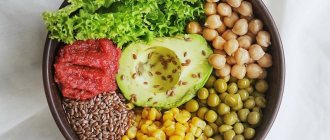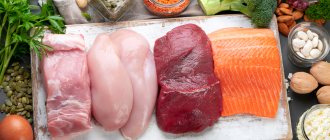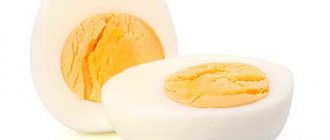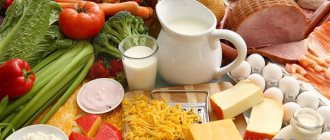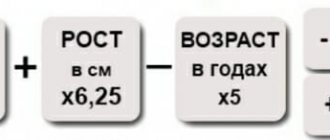Often, in the diet of someone who has followed the difficult path of calorie counting, only boiled chicken breast, rice, cucumbers and other simple foods remain. To calculate the energy value of a dish, just weigh it and enter the numbers in a special application.
A calorie counting guru can prepare a pot of borscht for a week, goulash, salad, cutlets and always know the energy value of a portion. To do this, you need to learn how to calculate how many calories, proteins, fats and carbohydrates are contained in 100 g of a complex dish.
Let's figure out how to do this, using the example of Olivier salad, which is not the most useful, but relevant on the eve of the New Year.
To prepare the salad you will need:
- 300 g boiled potatoes;
- 300 g of Doctor’s sausage;
- 5 eggs;
- 150 g pickled cucumbers;
- 200 g canned green peas;
- 120 g mayonnaise.
Why and how to count calories, what is needed for this
To many, this technique may seem overly complicated, but this is only at first glance. Reasonable dietary restrictions will allow you to maintain the desired physical shape and make your diet more balanced. A competent approach to this issue will help you gradually adjust your eating habits. Counting calories allows you not to give up eating certain foods, but to make losing weight more comfortable.
If you eat fewer calories than your body can convert into energy, your body will use stored fat to restore energy. On the one hand, it seems that it is much easier to follow a strict diet in order to achieve the desired result as quickly as possible. But after quickly achieving results, there is a “rollback”: you want to loosen control and eat sweets or junk food. As a result, a person receives a short-term effect, but in the long term risks gaining weight again, and even more.
Calculation of daily calorie needs for women of different age categories
Women 18-30 years old (0.0621*weight in kg+2.0357)*240=kcal
Women 30-60 years old (0.0342*weight in kg+3.5377)*240=kcal
Women over 60 years old (0.0377*weight in kg+2.7545)*240=kcal
Rule of hand
You can use your palm to determine the recommended serving size for different foods at each meal:
1. high-protein food - should be the size of a palm without fingers, the same size and thickness (a piece of meat, fish, poultry, a portion of seafood, cottage cheese or eggs).
2. vegetables and fruits (in any form, except juices, for example, a portion of salad) – the size of a fist (and don’t forget, you should eat at least 500 grams of vegetables and fruits per day), for those who are losing weight, we exclude potatoes (we classify them as side dishes) and very sweet fruits - grapes, bananas, figs, dates, persimmons.
3. portion of side dish (cereals, pasta, potatoes) – the size of a handful (approximately how much will fit in the palm of your hand). This item can be replaced with 1-2 pieces of yeast-free bread or crispbread.
4. portion of fats (butter, nuts, cheese, etc.) – the size of a thumb: a handful of nuts (about 30g per day), 1 tablespoon per day of any vegetable oil (in the form of salad dressing).
Photo: istockphoto.com
Advantages of the method
This technique allows you to establish a healthy diet without stress for the body and abandon significant restrictions, due to which “breakdowns” most often occur. When you put your body on a strict diet, you create unbearable conditions for it. As a result, it begins to create additional fat reserves, and your weight increases.
Knowing how to correctly count calories and use this information in practice, you can create a complete, healthy diet. This method of losing weight brings benefits to the body, which cannot be said about hunger strikes and various mono-diets.
Your favorite foods will continue to remain on the menu, and you just need to maintain your calorie limits. In order not to go beyond the norm, you will begin to gradually give up eating harmful foods and replace them with healthier ones. At the same time, you can enjoy your favorite treat whenever you want.
Gradually you will learn to plan your diet and fill it with the right foods. You will begin to monitor your own nutrition and take a more thoughtful approach to purchasing groceries.
Constantly counting calories for weight loss will ensure that your body gets enough nutrients: fats, proteins and carbohydrates. Such weight loss will be safe and uniform, thanks to which the final result will exceed your expectations. By controlling your diet, you can avoid many negative aspects. For example, against the background of a lack of fat, problems with the hormonal system progress, and a deficiency of carbohydrates leads to a loss of strength and energy. Many diets are built on maintaining an excess of proteins, but this is also wrong, since it can give impetus to the development of kidney and gastrointestinal diseases.
Calorie-based meal planning
Calculation of daily calorie content for a moderately hypocaloric diet (formula adopted and approved by WHO)
1. Calculation of basal metabolic rate:
Women
18-30 years: 0.0621*real body weight in kg +2.0357
31-60 years: 0.0342*real body weight in kg +3.5377
over 60 years: 0.0491*real body weight in kg +2.4587
The result obtained is multiplied by 240 (conversion from mJ to kcal)
2. Calculation of total energy expenditure adjusted for physical activity:
Baud rate 1.1 is low
1.3 moderate
1.5 high
3. Calculation of the hypocaloric daily diet:
Subtract 500-600 kcal from the figure obtained in formula No. 2.
By counting calories, you take care of your own body. If, in addition to proper nutrition, you practice sports and maintain muscle mass, then your figure will become more toned. Proper nutrition prevents unwanted muscle loss. The result of losing weight will be more effective and lasting.
2-3 months of regular calorie counting are enough to adjust your eating habits and gain an understanding of what your ideal lunch should look like. Gradually, you will remember approximately what calorie content a particular product has, and you will make combinations without doing calculations on paper. All information will already be stored in memory.
Now “gluttonous days” will not be able to destroy your figure. To compensate for such a “breakdown”, you will only need to do an energy-intensive workout or reduce your calorie intake for a couple of days. Gradually, you will learn to maintain the achieved physical shape without grueling weight loss. Maintain a slight calorie deficit to stay in great shape.
Food delivery services
For some people, the salvation is ordering food through a food delivery service. You and a nutritionist calculate the required calorie content and diet composition and select a nutrition program from a variety of existing delivery services. Who is this method suitable for:
- for those who don’t like or don’t have time to cook,
— those who need a quick, but at the same time correct and lasting effect of fat burning or gaining muscle mass (preparation for significant events in life),
— for those who want to receive help (a kind of training in proper nutrition) in the first stages, and then continue to cook on their own,
- women after the birth of a child, when they need to lose weight properly, but have no time to cook,
- for those who are busy at work, when it is more important to focus on their career, but at the same time maintain a properly balanced diet.
Photo: istockphoto.com
How to count calories to effectively lose weight?
How to count calories and learn to control your own nutrition? Take a few simple steps:
- set a certain calorie value for your daily diet;
- start recording and analyzing all the foods you eat during the day;
- Watch for improvements in your own figure and continue moving towards your goal.
When counting calories, you should adhere to a certain algorithm. First you need to analyze the level of metabolism characteristic of your body. Depending on the age group, body weight and physical activity, our body requires a certain amount of nutritional resources. Use the Harris-Benedict formula to estimate your metabolic rate.
- Women: BMR= 9.99 * weight (in kg) + 6.25 * height (in cm) – 4.92 * age (years) – 161
- Men: BMR = 9.99 * weight (in kg) + 6.25 * height (in cm) – 4.92 * age (years) + 5
where BMR is a key indicator of metabolism (basal metabolic rate).
Having an idea of this characteristic, assess your level of physical activity per day. The fitness activity factor must be multiplied by the basal metabolic rate factor. The physical load coefficient will be:
- 1.2 – for minimal physical activity (in its absence, physical inactivity, minimum movements)
- 1.375 – with minor (walking, weak daily activity per day)
- 1.46 – at an average level (training 4-5 times a week, sufficient load per day)
- 1.55 – above average (high intensity of exercise 5-6 times a week, good activity per day)
- 1.64 – with increased (daily training, increased daily load)
- 1.72 – at high (daily ultra-intense training)
- 1.9 – very high (this applies to professional athletes during preparation for competitions).
Be careful: when determining the coefficient, try to build on the total activity throughout the day. So, if you spend most of your workday sitting, but regularly go to the gym, then don't assign yourself an activity level higher than 1.37. Even training as hard as you can can't compensate for being immobile all day.
Evaluate the final result. By multiplying the resulting values, you can get an idea of your personal calorie intake. If you plan your diet taking into account the received norm, you will keep your weight at a constant level. You will receive the so-called caloric intake to maintain your weight at a certain level. To achieve a slight calorie deficit, their value must be reduced by 10-15%. This is enough to get rid of minor excess weight. If you need to get rid of more than 40 kg of excess weight, then the calorie deficit should be 25-30%.
Calorie content of ready meals
Here we have compiled a list of the most popular dishes that can be found in the diet of every person. The table shows the composition of BJU, as well as calorie content per 100 grams of product.
| Name | B | AND | U | Kcal |
| Beef azu | 12 | 14,2 | 10,2 | 215 |
| Chops | 27,8 | 30 | 2 | 385 |
| Pancakes with kefir | 6,1 | 12,3 | 26 | 234 |
| Borsch | 1 | 2 | 6,7 | 50 |
| Potato dumplings | 4,5 | 3,8 | 18,6 | 125 |
| Chicken cutlets | 18 | 10,5 | 13,7 | 221 |
| Boiled chicken fillet | 30,4 | 3,5 | 0 | 153 |
| Paste | 3,5 | 5 | 19 | 135 |
| Okroshka with meat on kvass | 2,1 | 1,7 | 6,3 | 53 |
| Dumplings | 12 | 13 | 29 | 275 |
| Traditional pilaf | 4,2 | 6 | 14,9 | 150 |
| Salad with crab sticks | 9,2 | 7,4 | 5,9 | 128 |
| "Caesar" | 15 | 10 | 9 | 190 |
| Pea soup | 4,4 | 2,4 | 8,9 | 66 |
How to count calories correctly?
We count calories and lose weight if we do everything right. Get yourself a personal food diary. All numerical values must be recorded on paper to get a clear picture. Don't rely on your own memory, because you always run the risk of overeating or not eating enough. Today it has become much easier to maintain a diet, because special programs have been created for this. They automate the entire process. Choose an easy-to-use mobile application for yourself and start using it actively.
Remember: losing weight by counting calories should not be assessed “by eye”. Buy yourself an electronic kitchen scale. Without this equipment, the count cannot be accurate. In the mobile application you can get information about the calorie content of each product and its energy value, but it will be approximate. You shouldn’t rely solely on it. Weigh all products in their “raw” form, that is, before cooking. This will allow you to get a more objective picture.
When weighing, the product must be separated from the packaging. If it is meat, weigh it without bones. Try to get into the habit of planning your menu for the whole day in advance. This way you will protect yourself from “disruptions” and surprises associated with the lack of certain products in the house. When planning your diet, be sure to leave yourself a corridor of 100-200 kcal in case unforeseen circumstances arise - for example, if you go out for a snack with colleagues.
If your plans for the day include preparing a complex dish that requires several ingredients, then you should not calculate its calorie content using information from the Internet. Before starting the cooking process, weigh each ingredient and then add up the resulting values. This will make the calculation more accurate.
Try not to use fast food outlets. It is difficult to count calories there, but it is easy to consume them significantly more than the daily norm. Train yourself to bring breakfast and lunch from home to strictly control your own diet. This will allow you to get your body into the desired shape in record time.
If one day you significantly exceed your daily caloric intake, then under no circumstances torture yourself with hunger strikes. Avoid so-called “fasting days.” They do not lead to anything good, and also disrupt metabolic processes. Stick to your previously established calorie range and increase your level of physical activity for a few days. This will be quite enough to solve the problem.
What data is needed for calculations
Do not use other people’s calculations; calculate the daily norm of KBJU specifically for yourself. You will need the following data:
- age;
- floor;
- lifestyle (sedentary, active, heavy physical activity, etc.);
- metabolism;
- Goal: lose weight, gain weight, maintain body weight.
How to calculate KBJU once? It is impossible to calculate the norm of KBZHU and use it all your life. The initial data will change and the norm will change along with it. Carry out calculations at least once a year, the success of the final goal depends on it.
We calculate the norm of proteins, fats and carbohydrates
Calculations are made to maintain the balance of nutrients. Again, the ratio of proteins, fats and carbohydrates specifically in your case depends on the result you are achieving.
BJU ratio for weight loss
- Carbohydrates - 40%
- Proteins - 30%
- Fats - 30%
The given percentage is considered ideal for weight loss.
BZHU ratio for weight gain
- Carbohydrates - 45-55%
- Proteins - 30-35%
- Fats - 25-30%
When calculating, keep in mind that:
1 g protein = 4 kcal
1 g fat = 9 kcal
1 g carbohydrates = 4 kcal
